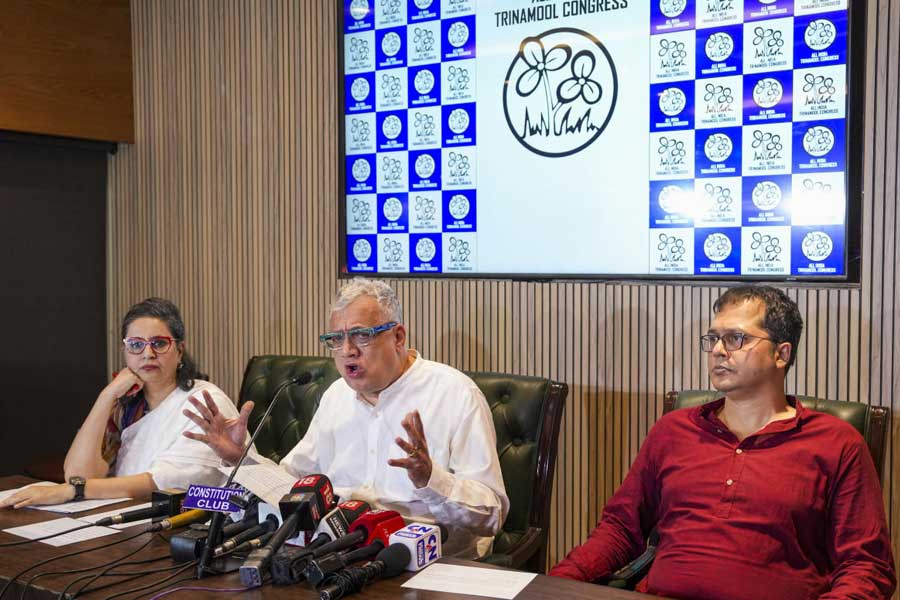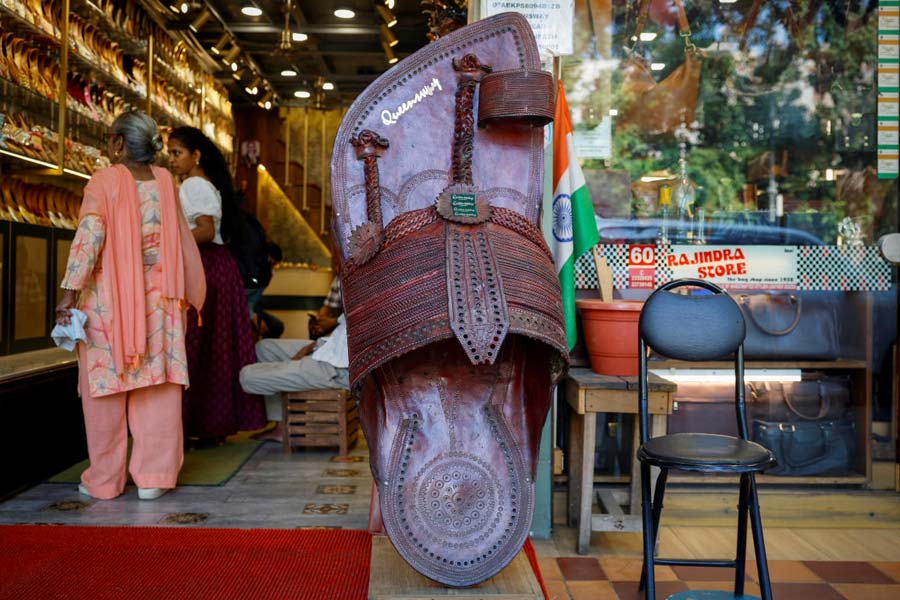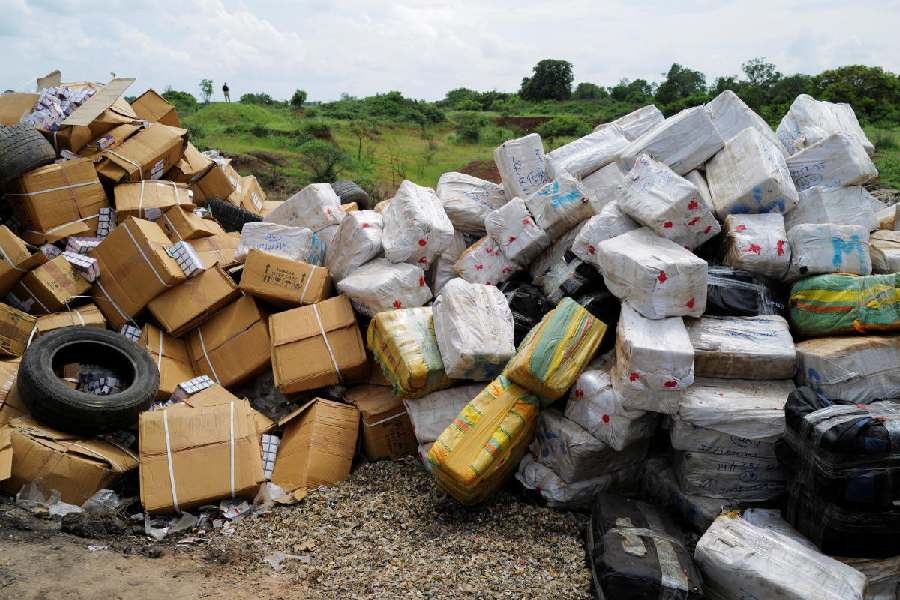 |
| FADED GLORY: Like so many beautiful Calcutta buildings, the Currency Office in Dalhousie has seen better days; (below) Paul Theroux |
 |
Rajiv Gandhi called it a dying city. Dominique Lapierre called it the City of Joy. Now Paul Theroux, known for his best-selling travel books such as The Great Railway Bazaar and Riding the Iron Rooster, has given another spin to the Calcutta story — a place of spectacular corruption and decay that is at once enervating and regenerating.
Theroux’s latest novel, A Dead Hand: A Crime in Calcutta, tells the story of Jerry Delfont, an American travel writer who has run out of ideas and is afflicted with a serious case of writer’s block. Or “dead hand”, as he calls it. He comes to Calcutta on a lecture tour, and then lingers in the city, perhaps to find that ineffable something that will make the words flow again. What he finds, though, is the enigmatic Mrs Merrill Unger, an American Indophile, a saviour of street children and a high priestess of tantric massage, a beautiful temptress who seems as much at home amidst the gory rites of the Kalighat temple as she is in the palm-fringed, aseptic precincts of the Oberoi Grand.
Part earth mother, part devil woman, Mrs Unger casts her spell on Delfont and he follows her like a man possessed, giving himself up to her tantric (read: erotic) ministrations that arouse his kundalini, or the energy centre of his being.
Incidentally, this is Theroux’s second, and consecutive, work of fiction based in India. The last one, The Elephanta Suite (2007), was a triptych of novellas on Americans who delve into India in all its chaos and contradictions, often with catastrophic consequences.
So what prompted Theroux to write a novel set in Calcutta? In a conversation via email, the writer, who is based in Hawaii, replies, “There is so much in Calcutta to stimulate, provoke, infuriate and satisfy. The layers of society, the vastness, the tang, the colour, the food, the always negotiating populace. Though some aspects of the city have changed, it is still the astonishing architectural and cultural marvel that it has been for hundreds of years — a usable antique.”
When he visited Calcutta in 2008, Theroux probably got a taste of exactly how the city could “provoke” and “infuriate”. The Calcutta Book Fair that he had come to inaugurate was cancelled at the last minute owing to protests that it would sully the Maidan. In a city as polluted and uncared for as Calcutta, that must have seemed like a weird irony to Theroux.
In fact, many of the experiences of that trip seem to have found their way into A Dead Hand. But Theroux insists that by early 2008 the book was already in progress. “But of course, I used that visit to explore the city more deeply,” he says.
That he did explore the city meticulously is reflected in almost every page of A Dead Hand. And whether it is such venerable Calcutta institutions as the Oly Pub or the New Market, grotty little hotels or heaving railway stations, whether it is the sad bunch of drinkers at Roxy Bar or the devotees twitching with veneration before the goddess in Kalighat — each is recorded with Theroux’s keen eye for detail.
He even peppers the narrative with Bengali phrases, albeit somewhat incongruously in places. For example, Mrs Unger says to an unknown beggar, “Namashkar. Apni keman achen?” And when pestered for alms, she asks “Dam koto?” But such linguistic howlers apart, Calcutta is diligently signposted throughout the book.
Did he make several trips to the city then to bone up on local colour? Theroux replies, “Over the past 35 years I have been to Calcutta a number of times — always a pleasurable and edifying experience.”
But to Jerry Delfont, the protagonist of A Dead Hand, the city seems neither pleasurable nor edifying. Indeed, his vision of Calcutta is one of unrelieved bleakness — a teeming, festering, crumbling mess that’s grim to the point of being repulsive. Sample this: “Calcutta was dense with restless people, where the stinks were so sharp they seemed audible, the diesel fumes of taxis and buses, the reek of garbage, of shit, of risen dust that was also like a high pitched whine, the vibration of dirt, the sweetish tang of decay…”
And here’s how Delfont describes Bengalis: “Their love of discussion was comic, especially in Calcutta, which was falling apart as all the Bengalis went on yakking, yakking, yakking.”
Of course, this is not the first time that Theroux has portrayed India — and Indians — in a less than flattering light. In The Elephanta Suite, for instance, one of the characters describes India “not as a country but a creature, a monstrous body crawling with smaller creatures, pestilential with people… sometimes angry and loud, sometimes passive and stinking, always hostile, even dangerous.”
Nor is this the first time that a Western writer has found Calcutta to be a city of despair and decay. More than a century ago, Rudyard Kipling wrote about Calcutta with distaste: “Chance-directed, chance-erected, laid and built/ On the silt… And above the packed and pestilential town/ Death looked down.”
But Theroux’s response to the city is perhaps a little more complicated. For he insists that the views expressed by his characters are not his own. And to drive home that point, he decides to make an appearance in the narrative. “I wanted to make it blindingly apparent that I am not the narrator of this book,” he explains. The two men — Theroux, the successful writer, and Delfont, the washed out hack who looks upon the decrepitude of Calcutta as a metaphor of his own diminished powers — warily size each other up sitting on the lawns of that haven of the Western budget tourist, the Fairlawn hotel on Sudder Street.
Whether this succeeds as a literary device is debatable, but Theroux feels that it clearly dissociates Delfont’s views from his own authorial vision. “As you see, Jerry is an envious and unconfident hack and Paul Theroux is a confident and companionable fellow who loves being in Calcutta.”
Did he have his tongue in his cheek when he said that? This being an email interview, one does not know. But ask Theroux why he based two fictional works in Indian cities, and he replies that what drew him was “the high density of Indian life”.
At its core, A Dead Hand too tries to express the density and contradictions of Indian life. “I was thinking how so much of Indian life has a bright side and a dark side, often a reflection of the Hindu deities. But this is also the human condition,” says Theroux. “I am an American and can’t presume to write with any profound understanding of an Indian. And so I made the main character Mrs Unger, an American Indophile, who possesses many of these same qualities.”
Indeed, ultimately, Mrs Unger, and perhaps by extension Calcutta too, becomes a symbol of the dual and opposing forces of nature, creating and destroying, nurturing and corrupting — an embodiment, as it were, of death as well as life.
Theroux plans to be back in India next year. For another India novel? He is not telling, but if he were indeed to write one more, it would probably be set in Assam. “It is truly a place that is off the map,” he says. He also refuses to divulge what he is working on at present. “I am superstitious about discussing unfinished work,” he says, “feeling that if I do, it might not get finished.”
Of all his Calcutta experiences, the one he remembers most is “watching the bloody beheading of a bleating black goat in Kalighat, and then being offered mutton curry later in the day — which, I declined”.
Maybe it summed up the essence of Theroux’s India experience — the violence and the tenderness — the two sides of the same coin.










